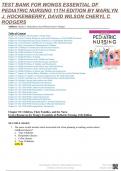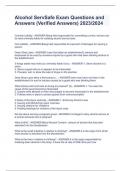-
1. Examen - C211 maternal child nursing care 6th edition perry test bank
-
2. Examen - med surg 2 exam 1-comprehensive review of medical surgical nursing ii exam
-
3. Examen - Adult health nursing 6th edition by kockrow – test bank instant download with answe...
-
4. Examen - Test bank fundamentals of nursing 10th edition potter perry test bank (q&a) all chapt...
-
5. Examen - Test bank for canadian fundamentals of nursing, 6th edition| test bank for canadian f...
-
6. Examen - Toc 2021 nursing osce information booklet v1.5
-
7. Examen - test bank lewis's medical-surgical nursing assessment and management of clinical pro...
-
8. Examen - Nursing 114 ati questions for exam 1 (rn adult medical surgical nursing) questions an...
-
9. Examen - Fundamentals nursing : patient safety and quality answered!!!
-
10. Examen - Cna final exam/ 100 answered questions for cna exam 2022/certified nursing assistant ...
-
11. Examen - nursing nsg5003 week 6 mid-term
-
12. Notes de cours - Nur 101 fundamental of nursing procedure manual for pcl course
-
13. Examen - Test bank pharmacology and the nursing process 9th edition linda lane lilley, shelly ...
-
14. Examen - Nursing care of the adult -- diagnostic testing answered
-
15. Examen - Nursing fundamentals final exam questions and answers latest updated
-
16. Examen - Exam 1 - psychiatric/mental health nursing practice questions (answered) complete ver...
-
17. Examen - Test bank for fundamentals of nursing theory concepts and applications 4th edition by...
-
18. Examen - Test bank for davis advantage for maternal-child nursing care 3rd edition by scannell...
-
19. Examen - Test bank for fundamental concepts and skills for nursing 6th edition by patricia a. ...
-
20. Examen - Test bank for fundamentals of nursing 11th edition potter perry chapter 1-50 |newest ...
-
21. Examen - Test bank public health nursing: population-centered health care in the community 10t...
-
22. Examen - Test bank for wongs essential of pediatric nursing 11th edition by marilyn j. hockenb...
-
23. Examen - Test bank pediatric nursing a care based approch 1st edition tagher knapp
-
24. Examen - Test_bank_for_leading_and_managing_in_nursing__8th_edition_by_patricia_s._yoder_wise_...
-
25. Examen - Test bank for maternal child nursing care 7th edition by shannon e. perry, marilyn j....
-
26. Examen - Test_bank_for_nursing today transition and trends 10th edition by zerwekh_all_chapter...
-
27. Examen - Test bank: community and public health nursing: promoting the public’s health 10th ...
-
28. Examen - Test bank for timby's introductory medical-surgical nursing, 13th edition (donnelly-m...
-
29. Examen - Test bank for leadership roles and management functions in nursing 10th edition marqu...
-
30. Examen - Test bank for foundations and adult health nursing 7th edition by kim cooper kelly go...
-
31. Examen - Testbank for fundamentals of nursing all chapters covered
-
32. Examen - Clc exam 2024 questions and answers verified by nursing examiners
-
33. Examen - Test bank for neeb’s mental health nursing 5th edition by gorman
-
34. Examen - Test bank for nursing for wellness in older adults miller 8th edition all chapters co...
-
35. Examen - Test bank for community public health nursing 8th edition by mary a. nies, melanie mc...
-
36. Examen - Test bank for leading and managing in nursing 7th edition by patricia s. yoder-wise; ...
-
37. Examen - Chapter 49: endocrine problems lewis: medical-surgical nursing, 10th edition exam que...
-
38. Examen - Nursing jurisprudence and ethics for texas nurses exam questions and verified answers...
-
39. Examen - Texas nursing jurisprudence exam questions with complete correct answers
-
40. Examen - Galen college of nursing nu110 exam #2 questions with complete solutions verified gra...
-
41. Examen - comp galen college of nursing exam latest actual questions and verified answers 100%...
-
42. Examen - Fundamentals of nursing (galen college of nursing) exam questions and verified correc...
-
43. Examen - electrolyte imbalances galen college of nursing exam latest questions and verified c...
-
44. Examen - Pediatrics nursing exam 1 galen college of nursing verified questions with complete s...
-
45. Examen - Exam 2 fundamentals nursing galen college questions and verified updated correct answ...
-
46. Examen - Ob exam 1 galen college of nursing latest questions and answers with complete solutio...
-
47. Examen - Ob exam 2 galen college of nursing questions with 100% solved solutions verified late...
-
48. Examen - Ob exam 2 galen college of nursing questions 100% solved and verified correct answers...
-
49. Examen - Nursing and healthcare lpn galen college exam 2 questions with complete solutions ver...
-
50. Examen - Med-surg exam 3- galen college of nursing exam questions with complete solutions veri...
-
51. Examen - Adult health exam 2 galen college of nursing questions with complete solutions verifi...
-
52. Examen - Nsg 3600 exam 1 pediatric nursing galen college of nursing questions with complete so...
-
53. Examen - Exam 2 - advanced med surg galen college of nursing questions and verified correct an...
-
54. Examen - Nu110 - chapter 1: the evolution of nursing exam questions with complete solutions an...
-
55. Examen - Nu110 fundamentals of nursing exam questions and verified answers graded a+
-
56. Examen - Nu110 fundamental concepts and skills for nursing exam questions and verified correct...
-
57. Examen - Nu110 - chapter 2: legal & ethical aspects of nursing exam questions with complete so...
-
58. Examen - Test bank for davis advantage for understanding medical-surgical nursing, 7th edition...
-
59. Examen - Nur 2520 hesi all exam questions and answers new update 2023/2024 top ranked a+ best ...
-
60. Examen - Test bank for fundamentals of nursing - vol 2: thinking, doing, and caring 4th editio...
-
Montrer plus






